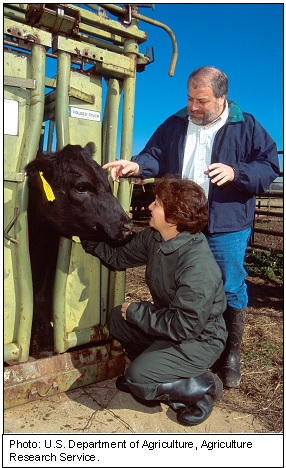Veterinarians: Front-line Responders to Animal Disease Outbreaks
 You may recall events such as outbreaks of mad cow disease and foot and mouth disease in the United Kingdom and other countries. Foot and mouth disease, in particular, is a highly contagious viral disease that can quickly spread through livestock. In 2001, an outbreak of foot and mouth disease in the U.K. resulted in the slaughter of more than 4 million animals, and more than $5 billion in losses to the U.K.’s food and agriculture sectors.
While the United States has been free from foot and mouth disease since 1929, the disease remains present in more than half of all nations.
According to the U.S. Department of Agriculture (USDA), just one contaminated animal product coming into contact with one susceptible U.S. animal could trigger a nationwide disease outbreak.
Moreover, a White House council estimated that an act of biological terrorism that spread foot and mouth disease among several states would affect almost half the nation’s beef, dairy, and swine, and cost the nation billions of dollars.
How many veterinarians do you need in an emergency?
The USDA is the lead agency for emergency response to significant incidents threatening the health of animals. Consequently, the department is responsible for planning in such national emergencies, including for any needed veterinary expertise.
However, we found that the USDA has not developed reliable estimates of the number of veterinarians needed for emergency response to an animal disease outbreak. In one study, USDA worked with other federal agencies to estimate the number of needed veterinarians, but the study based the number on a model that the department did not verify or validate.
Without reliable estimates, the USDA may not have a sufficient number of veterinarians to respond to the most serious animal disease outbreaks.
In such an emergency, the USDA could augment their veterinarian workforce through various arrangements, such as by using
You may recall events such as outbreaks of mad cow disease and foot and mouth disease in the United Kingdom and other countries. Foot and mouth disease, in particular, is a highly contagious viral disease that can quickly spread through livestock. In 2001, an outbreak of foot and mouth disease in the U.K. resulted in the slaughter of more than 4 million animals, and more than $5 billion in losses to the U.K.’s food and agriculture sectors.
While the United States has been free from foot and mouth disease since 1929, the disease remains present in more than half of all nations.
According to the U.S. Department of Agriculture (USDA), just one contaminated animal product coming into contact with one susceptible U.S. animal could trigger a nationwide disease outbreak.
Moreover, a White House council estimated that an act of biological terrorism that spread foot and mouth disease among several states would affect almost half the nation’s beef, dairy, and swine, and cost the nation billions of dollars.
How many veterinarians do you need in an emergency?
The USDA is the lead agency for emergency response to significant incidents threatening the health of animals. Consequently, the department is responsible for planning in such national emergencies, including for any needed veterinary expertise.
However, we found that the USDA has not developed reliable estimates of the number of veterinarians needed for emergency response to an animal disease outbreak. In one study, USDA worked with other federal agencies to estimate the number of needed veterinarians, but the study based the number on a model that the department did not verify or validate.
Without reliable estimates, the USDA may not have a sufficient number of veterinarians to respond to the most serious animal disease outbreaks.
In such an emergency, the USDA could augment their veterinarian workforce through various arrangements, such as by using
- a volunteer force of private veterinarians,
- Department of Defense staff, or
- agreements with other nations, such as Canada and the United Kingdom, to provide veterinarians.
- Questions on the content of this post? Contact John Neumann at neumannj@gao.gov.
- Comments on GAO’s WatchBlog? Contact blog@gao.gov.

GAO's mission is to provide Congress with fact-based, nonpartisan information that can help improve federal government performance and ensure accountability for the benefit of the American people. GAO launched its WatchBlog in January, 2014, as part of its continuing effort to reach its audiences—Congress and the American people—where they are currently looking for information.
The blog format allows GAO to provide a little more context about its work than it can offer on its other social media platforms. Posts will tie GAO work to current events and the news; show how GAO’s work is affecting agencies or legislation; highlight reports, testimonies, and issue areas where GAO does work; and provide information about GAO itself, among other things.
Please send any feedback on GAO's WatchBlog to blog@gao.gov.
